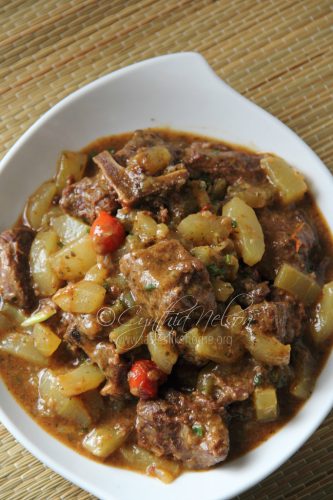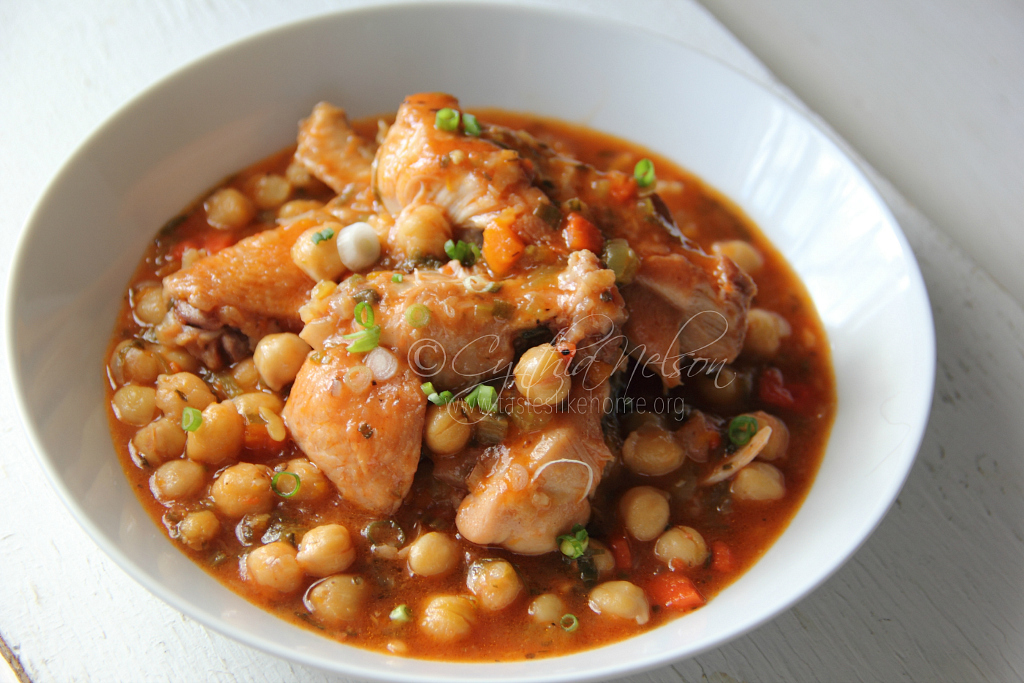
A stew is one of those dishes that when made and eaten, sets your soul at ease; it comforts, it fortifies. Perhaps stews evoke these feelings due to the cooking process involved that results in succulent morsels and a sauce/gravy brimming with incredibly deep flavour from all the ingredients. Such stews give you pause; they force you to slow down – to prepare them and to enjoy them.
A stew means different things for different people depending on where you are from but for the purposes of this column, a stew means seasoned meat or poultry cooked low and slow with lots of liquid and some flavouring that also gives colour – burnt sugar, browning, tomato paste, tomato sauce or annatto (achiote).

One of the many things that’s great about a stew is that it does not require expensive cuts of meats or poultry, actually, the cheaper the cuts, the more flavourful the stew. And you can add so many other things to a stew – vegetables, beans, peas, potatoes and dumplings. It is a hearty dish that can feed a large family or a crowd. What’s wicked about a stew is that the next day or the day after, it gets even better.
There are five main things about a stew to be considered before venturing off into stew-land: the cut of meat or poultry, the cooking liquid, the seasoning for base flavour, the colour flavouring and the heat. A little thought upfront results in a top-notch stew that can see you being showered with love and affection. The major drawback could be that you are asked to make this often. But think of it this way, people will know that when you bring out that big pot of stew that you mean business, you’re bringing your ‘A’ game to the table. And when you determine (depending on the crowd) what you’re serving with the stew – rice, bread, ground provisions, dumplings, Foo-foo, Cou-cou, pasta or potatoes, man you know that you got them right where you want them. Enough said.
So, let’s look at these five key elements to making a stew.
The main ingredient
Lamb, beef, goat, mutton, chicken, turkey, veal and pork are all ideal for stewing, fish too. However, not all parts are best suited to this type of cooking. You see, a stew is all about developing a deep flavour and this comes from choosing the most flavourful cuts of the meat/poultry. The most flavourful cuts are the parts of the animal that are worked the most; the parts that have muscle, tissues, fat and bones. In the larger animals, we are talking here about shanks, hocks, shoulder, feet, ribs and belly. On the poultry side, it’s the wings, thighs, drumsticks, and backs. Stews are about low and slow cooking to develop texture and flavour; it is for this reason that the ‘cheaper’ cuts of meat are ideal for stews. The low heat and slow cooking break down the muscles and tissues in the meat to make them tender, or as we like to say, fall-off-the-bone.
The base seasonings
There is more than one method to the seasoning for a stew. Most of us in the Caribbean, season the meat/poultry with homemade green seasoning and we might add in things such as Worcestershire sauce or soy sauce. Others may simply season with salt and pepper and a dusting of flour. Yet another group will create a mirepoix – a finely chopped mixture of onions, carrots and celery to start off the flavour base of their stew. Each method or combination thereof creates its own unique taste.
Base flavourings
There are two ways to kick off the development of flavours in a stew. The first one is browning the meat/poultry first, to add colour, crust and texture. The second is by choosing how you want to colour your stew. Some people like a brown stew (like the famous Trinbagonian Brown Chicken Stew made with burnt sugar), others opt for using store-bought browning, and in Guyana some people may use cassareep. Then there is another group that does not like their stew brown but rather, red or with deep hues of pink, they opt for fresh tomatoes, tomato sauce or tomato paste. Again, the colouring chosen will impact on the overall flavour of the stew. All of these colouring-flavouring options are excellent; it really comes down to how you like your stew.
The liquid
The sauce/gravy of a stew is really where the money is. This is where the bedrock of flavour dwells deeply. Sure, the meat is tender, but without the sauce/gravy, it is just meat. A stew develops flavour from the meat, seasonings, flavourings and any other ingredients added, however, the liquid you choose to marry all those ingredients can determine the sublimity of your stew. Water and stock (vegetable, chicken, beef, veal or bouillon cubes) are usually the two main options. Personally, I prefer water. The main reason that I prefer water is that given the nature of cooking a stew – building layers of flavours and then cooking everything low and slow, allows for all the ingredients to shed and invest their essence into the sauce. If you think about it, it is the same principle involved in making stock – you boil the bones, shells, or carcasses with aromatics for a long period of time to extract the flavour. So, you are making a thick stock with meat when making a stew; that’s why I prefer using water.
Don’t get me wrong, it is okay to use stock when making stew, just be mindful that you are matching flavours, in other words, use a vegetable or chicken stock for stewed chicken. Veal or beef stock for a red-meat stew. A vegetable or chicken stock would work for a pork stew as well. Actually, vegetable stocks will work for any stew. The advantage of using stock in a stew is that you can make a quick stew and get great flavour without the long and slow cooking. This quick-stew cooking application, however, is best suited to ingredients that will not require a long cooking time such as fish, seafood or even chicken, particularly the breast.
The heat
Low and slow is the way to go for a stew. It is about a simmer – bringing the pot to a boil and reducing the heat to low. This approach allows the tougher cuts of meat or poultry to break down in such a way that the texture becomes tender and not stringy or mushy. The integrity of the meat remains intact. When a stew is cooked at constant roaring boil for the entire duration of cooking, the cooking liquid can dry out quickly and you may find yourself having to add more liquid because the meat is still tough. Another effect is that the meat and sauce will not meld in a way that benefit each other. In other words, the sauce is not getting a long enough time to intensify in flavour by reduction and the meat is not relaxing in a way that allows the sauce to penetrate and carry the seasonings and flavours to the meat.
A pressure cooker is an excellent piece of equipment for shortening the cooking time for a stew in terms of breaking down tough cuts of meat. However, cooking a stew on high heat in a pressure cooker can result in the meat being all busted up and you being left with shreds of meat and a sauce waiting to develop flavour. Or you could end up with meat that when chewed is like mush in your mouth. If you are going to use a pressure cooker, once the first whistle goes off (on high heat), reduce the heat to low for the duration of the cooking. Note, however, that if using a pressure cooker, you’ll need less cooking liquid and the cooking time would be significantly reduced. In some cases, once the pressure cooker is opened you may find that you have a little more sauce than you need. When this is the situation, return the pressure pot to the stove, uncovered, on high heat and let the sauce cook down until it is to your desired thickness.
Another way to cook stews is in the oven. Begin it on the stovetop in an ovenproof pot/pan with a cover. Start by browning the meat, adding the liquid, and then transferring the pot, covered, to your oven.
If you plan to add other ingredients to your stew such as potatoes, ground provisions, vegetables, or legumes, you must take into consideration how long or short a period of time these ingredients would take to cook. You do not want to add them too early and they melt or disintegrate because of the long cooking time needed for the protein. Some you may add at the beginning of the cooking process, half-way through or several minutes before the stew is done cooking.
Cynthia
cynthia@tasteslikehome.org






